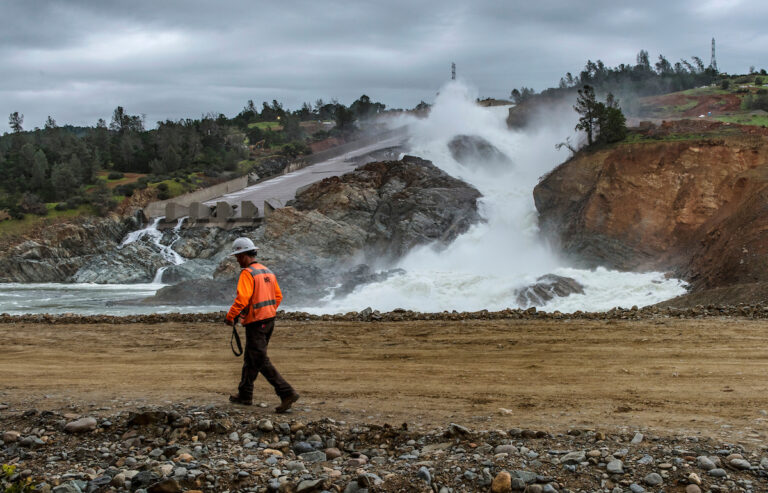Water rushes into the diversion pool Wednesday morning from the ravine carved out from the damaged Lake Oroville flood control spillway. The California Department of Water Resources continues its outflow release of 35,000 cubic feet per second at the Butte County, Calif. site. Photo taken April 26, 2017. Brian Baer/ DWR
Heavy rainfall in the Northeast on June 9-11, 2023, generated widespread flooding, particularly in New York’s Hudson Valley and in Vermont. One major concern was the Wrightsville Dam, built in 1935 on the Winooski River north of Vermont’s capital city, Montpelier. The reservoir behind the dam rose to within 1 foot of the dam’s maximum storage capacity, prompting warnings that water could overtop the dam and worsen already-dangerous conditions downstream, or damage the dam.
Hiba Baroud, associate professor and associate chair in the department of civil and environmental engineering at Vanderbilt University, explains how flooding stresses dams in a changing climate.
How serious is the risk when flooding overtops a dam?
Dam overtopping can result in erosion, which subsequently could lead to a dam breach or failure and a sudden, uncontrolled release of impounded water. The risk of dam overtopping results from the combined effect of a hazardous event, such as heavy rainfall, and the vulnerability of the dam. A vulnerable dam could be old, poorly maintained or not have enough spillway capacity to safely release water from the dam.
A dam’s design can affect its ability to withstand overtopping and resist failure. For example, concrete dams can typically better withstand certain levels of overtopping compared to soil embankment dams.
Overtopping is the leading cause of dam failures in the U.S. It accounts for 34% of all dam failures. How long water flows over a dam and the volume of water that flows over it are important factors in determining the likelihood that a dam will fail.
The consequences of a dam overtopping, and possibly failing, depend on several factors, such as the purpose of the dam, its size and its location. If a dam is designed for flood protection and is surrounded by homes, businesses or critical infrastructure, a large uncontrolled release of water could be catastrophic. Dams that are small and located in rural areas may cause less damage if they are overtopped or fail.
How old are most US dams?
There are more than 91,000 dams across the U.S., in all 50 states, with diverse designs and purposes. The average dam age is 60 years, and more than 8,000 dams are over 90 years old.
Every four years, the American Society of Civil Engineers produces a report card for […]
Full article: mavensnotebook.com

